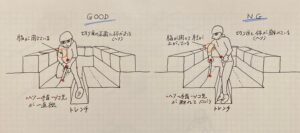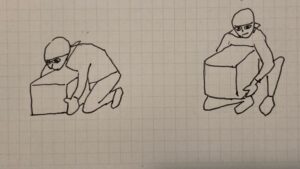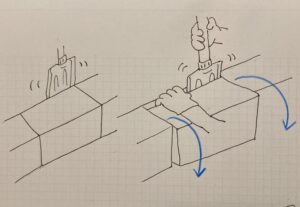切り抜き詳細
- 発行日時
- 2024-4-18 22:03
- 見出し
- ブロックが重くて硬い暖かい時期の心得 ノコギリの基本
- 記事詳細
-
つまづきのほとんどは、ノコギリの使い方です
いいブロックが切れないです!というケースのほとんどは、姿勢の問題が多いです。残雪期のブロック切り出しは力の使い方を間違えると、特に筋肉の少ない人はすぐ疲れてやる気が減退します。腱鞘炎にもなります、腰痛もきます。ノコギリに限らず何事も重要なのは、「大事な仕事はヘソの前20cmでやること」です。字を上手に書くときも、包丁で魚をおろすときも、合気道の技をかけるときも同じです。腕ではなく指先にエネルギーを集中できるからです。

ノコギリ扱うときの切り目と体の位置関係は長時間作業には大事です。無駄に疲れないように。ポイントは「ヘソの前」The relationship between the sawing angle and the body position is crucial for prolonged work with the saw. To avoid unnecessary fatigue, the key point is “in front of the navel.”
ブロックを切るときの体の立ち位置
ヘソの前20cm以内に手首があるとなぜ楽なのか?体の重心に近いから、全エネルギをノコギリに費やせるからです。脇を開き、腕を伸ばした先でノコギリに力をいれるのは無理です。距離20cmにするには、切りたい場所に「自分の身体を寄せる」しかありません。足場を進め、膝を曲げ、腰を落としたりしながら、ヘソを作業ポイントに近づけてください。そうすると、少ない力で楽にノコギリを動かせます。

ヘソとブロックをとにかくくっつける。体を寄せる、腹の上に抱える。重いものが持ち上がるAttach the navel to the block no matter what. Bring the body close, cradle it on the abdomen. Heavy objects will lift.
切り出したブロックを持ち上げるときもヘソから20cm以内
また重いブロックを運ぶときにもブロックをヘソの前10cmに近づけてから持ち上げます。これも重要です。この季節は気温が高く、宅急便大のブロックもかなりの重さになります。力があるからと、理に沿わない姿勢でブロックの切り出しを続ければいつか腰が痛くなるし、山行中なのに無駄なエネルギーも使います。ぜひ最小限の力技を覚えてください。
ブロックの前に足首を立てて正座して、ヘソをブロックになるべく近づけ、抱きかかえるようにして、自分のヘソの上に乗せるぐらい引き出してから立ち上がります。
抱きかかえるので上着全面のファスナーは上まで閉めておきましょう。懐に雪が入ると、融けて後で腹回りが濡れて寒い思いをします。

スコップは、指をいれる隙間を開けるだけの役割。力任せにやると、ブロックがじゃがいもになってしまうよ。取り出すときは手前に回転させて転がしだす。ハの字で切れば出てくる。The shovel serves only to create space for inserting fingers. Using force can turn the blocks into mashed potatoes. When extracting them, rotate and roll them forward. If cut properly, they’ll come out smoothly.
ショベルは指をいれる隙間を作るためだけの道具
ブロック取り出すとき力任せにショベルを使うと、安い製品だと首が簡単に折れてしまいます。ブロックはノコギリだけで切り離し、ショベルはそのブロックを2センチ動かすのに使うだけです。2cm隙間が空いたらそこに指を入れて、ブロックを手前側に転がして取り出します。ショベルを軽く刺し入れてもブロックがコトコト動かなければ、切れ目が奥でつながっていません。もう一度ノコギリで切れ目を合わせてください。コトコト動くのに出てこないときは、ハの字切りに問題があって引っかかっています。もう一度、表開き、上開きの方向に切れ目を入れ直してください。
気温高く落ちやすいので屋根材は厚いものを
この季節は午後の高温時間帯に、せっかく作った屋根が融けて落ちることがあります。屋根のブロックも20〜30cmの厚みのある大きなものを使えば、融けずに済みます。気温の低い時期は薄いブロックを乗せただけでも大丈夫なのですが。大きく重いブロックは不安定ですが、案外ブロック同士のくっつきが良く、大胆に内側にせり出しても、安定しています。サイコロ型のものだけでも屋根を塞げたりします。
今週は、みなイグルーを仕上げたあとは気温も高く風もないので、外にテーブル席を掘ってビールと鍋、月と星を楽しみました。最後にそれぞれ個室に戻って、戸締まりもおろそかに就寝。一人は外でゴロ寝しました。寒くなったら入ろうと作っておいた大集会室イグルーは作ったけど使いませんでした。
Most stumbling blocks come from improper sawing technique
Many cases of ‘can’t cut good blocks!’ stem from posture issues. Cutting blocks during the lingering snow season can quickly exhaust those with less muscle, leading to decreased motivation. It can also cause tendonitis and back pain. Whether it’s using a saw, writing neatly, filleting a fish, or executing an Aikido technique, the key is always the same: ‘Do important work within the first 20cm below the navel.’ This allows you to focus energy on your fingertips rather than relying solely on your arms.”
 HOME
HOME
 メニュー
メニュー
